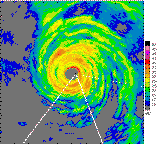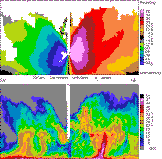|
| Device | Parameter | Units | Lower Fuselage | Tail |
| Transmitter | Frequency | MHz | 5370 | 9315 |
| Wavelength | cm | 5.59 | 3.22 | |
| PRF | Hz | 200 | 1600-3200 | |
| Pulse Length | s (m) |
6.0 (1800) |
0.25-0.50 (75-150) |
|
| Peak Power | kW | 70.0 | 60.0 | |
| Minimum Detectable Signal | dBm | -109 | -111 | |
| Antenna | Hor. Beam Width | deg | 1.1 | 1.35 |
| Vert. Beam Width | deg | 4.1 | 1.90 | |
| Gain | dB | 37.5 | 40.0 | |
| Polarization | N/A | linear (horizontal) |
linear (vertical) |
|
| Stabilization | deg | 5 (pitch, roll) |
25 (pitch, drift) |
|
| Radar | Velocity Nyquist interval | m/s | N/A | 12.88 - 25.6 |
| Maximum unambiguous range | km | 750. | 93.75 - 46.0 | |
| Example | Olivia (1992) |
 |
 |
The major drawback of the Lower Fuselage radar is the large vertical beamwidth (4.1) which causes inadequate illumination of the targets in the beam. Inadequate beam filling is a severe problem in the estimation of the reflectivity of a storm at ranges >60-90 km (see the Appendix of Marks, 1985). The critical parameters that determine the beam illumination of the target storm are the beam's vertical dimension and orientation, and the aircraft altitude. At close range there is little loss because the radar beam is narrow enough to be totally within the strong reflectivity region at lower altitudes in the storm. As range increases, the height of the center of the beam increases and more of the beam is unfilled, or filled with the less reflective portion of the storm. This problem can be solved by compositing a number of radar sweeps in time over a fixed domain(storm- or earth-relative)
The major drawback of the Tail radar is the 3.22 cm wavelength (X-band) and high PRF. X-Band radars suffer from intervening rain attenuation which limit the maximum range at which Doppler estimates are obtained. This problem is remedied by flying close to the area of interest, reducing the distance the beam has to travel through the intervening rainfall. The high PRF, coupled with the short wavelength result in a low velocity Nyquist interval and unambiguous range. The low Nyquist velocity is the hardest of the two to compensate for as intervening attenuation minimizes problems with second trip echoes. The low Nyquist velocity can be overcome through unfolding utilizing the measured component of the air velocity along the radar beam at the aircraft as a first guess. HRD has successfully unfolded velocities as high as 90 m/susing this approach in hurricanes.
 References
References
- Kollias, P., B.A. Albrecht, and F.D. Marks. 2003 "Cloud radar observations of vertical drafts and microphysics in convective rain." Journal of Geophysical Research, 108(D2) pp.4053
- Black, M.L., J.F. Gamache, F.D. Marks, C.E. Samsury, and H.E. Willoughby. 2002 "Eastern Pacific Hurricanes Jimena of 1991 and Olivia of 1994 pp. The effect of vertical shear on structure and intensity." Monthly Weather Review, 130(9) pp.2291-2312
- Kollias, P., B.A. Albrecht, and F.D. Marks. 2002 "Why Mie?" Bulletin of the American Meteorological Society, 83(10) pp.1471-1483
- Walsh, E.J., C.W. Wright, D. Vandemark, W.B. Krabill, A.W. Garcia, S.H. Houston, S.T. Murillo, M.D. Powell, P.G. Black, and F.D. Marks. 2002 "Hurricane directional wave spectrum spatial variation at landfall." Journal of Physical Oceanography, 32(6) pp.1667-1684
- Atlas, D., C.W. Ulbrich, F.D. Marks, R.A. Black, E. Amitai, P.T. Willis, and C.E. Samsury. 2000 "Partitioning tropical oceanic convective and stratiform rains by draft strength." Journal of Geophysical Research, 105(D2) pp.2259-2267
- Lee, W.-C., and F.D. Marks. 2000 "Tropical cyclone kinematic structure retrieved from single Doppler radar observations, Part II: The GBVTD-simplex center finding algorithm." Monthly Weather Review, 128(6) pp.1925-1936
- Lee, W.-C., B. J.-D. Jou, P.-L. Chang, and F.D. Marks. 2000 "Tropical cyclone kinematic structure retrieved from single-Doppler radar observations. Part III: Evolution and structures of Typhoon Alex (1987)." Monthly Weather Review, 128(12) pp.3982-4001
- Reasor, P.D., M.T. Montgomery, F.D. Marks, and J.F. Gamache. 2000 "Low-wavenumber structure and evolution of the hurricane inner core observed by airborne dual-Doppler radar." Monthly Weather Review, 128(6) pp.1653-1680
- Rogers, R.F., J.M. Fritsch, and W.C. Lambert. 2000 "A simple technique for using radar data in the dynamic initialization of a mesoscale model." Monthly Weather Review, 128(7) pp.2560-2574
- Dodge, P.P., R.W. Burpee, and F.D. Marks. 1999 "The kinematic structure of a hurricane with sea-level pressure less than 900 mb." Monthly Weather Review, 127(6) pp.987-1004
- Black, M.L., R.W. Burpee, and F.D. Marks. 1996 "Vertical motion characteristics of tropical cyclones determined with airborne Doppler radial velocities." Journal of the Atmospheric Sciences, 53(13) pp.1887-1909
- Marks, F.D., 1985 "Evolution and structure of precipitation in Hurricane Allen (1980)." Mon. Wea. Rev., 113, 909-930.
For more information on the Radars mail to : Frank.Marks@noaa.gov
Return to aircraft page.
Return to HRD page.
Updated June 16, 2003
 WP-3D Radars
WP-3D Radars